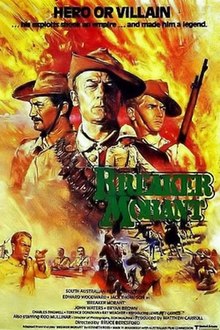This article needs additional citations for verification. (October 2015) |
| Breaker Morant | |
|---|---|
 Theatrical release poster | |
| Directed by | Bruce Beresford |
| Screenplay by |
|
| Based on |
|
| Produced by | Matthew Carroll |
| Starring | |
| Cinematography | Donald McAlpine |
| Edited by | William Anderson |
Production companies |
|
| Distributed by | Roadshow Film Distributors |
Release date |
|
Running time | 107 minutes |
| Country | Australia |
| Languages | English Afrikaans |
| Budget | A$800,000[1] |
| Box office | $4.7 million (Australia) $3.5 million (US/Canada)[2][3] |
Breaker Morant is a 1980 Australian war drama film directed by Bruce Beresford, who co-wrote the screenplay based on Kenneth G. Ross's 1978 play of the same name.[4][5][6]
The film concerns the 1902 court martial of lieutenants Harry Morant, Peter Handcock and George Witton—one of the first war crime prosecutions in British military history. Australians serving in the British Army during the Second Anglo-Boer War, Morant, Handcock, and Witton stood accused of murdering captured enemy combatants and an unarmed civilian in the Northern Transvaal. The film is notable for its exploration of the Nuremberg Defence, the politics of the death penalty and the human cost of total war. As the trial unfolds, the events in question are shown in flashbacks.
In 1980, the film won ten Australian Film Institute Awards including: Best Film, Best Direction, Leading Actor, Supporting Actor, Screenplay, Art Direction, Cinematography, and Editing. It was also nominated for the 1980 Academy Award for the Best Writing (Screenplay Based on Material from Another Medium).
Breaker Morant remains the movie with which Beresford is most identified and has "hoisted the images of the accused officers to the level of Australian icons and martyrs".[7][8] In a 1999 interview Beresford explained that Breaker Morant "never pretended for a moment" that the defendants were not guilty as charged. He had intended the film to explore how wartime atrocities can be "committed by people who appear to be quite normal". Beresford concluded that he was "amazed" that so many people see his film as being about "poor Australians who were framed by the Brits".[9]
- ^ Cite error: The named reference
strattonwas invoked but never defined (see the help page). - ^ Corman, Roger & Jerome, Jim. How I Made a Hundred Movies in Hollywood and Never Lost a Dime, Muller, 1990. p.191
- ^ Donahue, Suzanne Mary (1987). American film distribution : the changing marketplace. UMI Research Press. p. 294. ISBN 978-0-8357-1776-2. Please note figures are for rentals in US and Canada
- ^ Subsequent to the film's release, Ross – who began writing under the name "Kenneth Ross" to set himself apart from other creative Australians known as "Ken Ross" – found that he must write under the name of "Kenneth G. Ross" to distinguish himself from that other, also famous, Kenneth Ross: the Scottish/American Kenneth Ross who was the scriptwriter for The Day of the Jackal.
- ^ Kit Denton's 1973 book The Breaker was not the source (see Ross' litigation for details).
- ^ Bennett, C. (Friday, 4 July 1980), "Breaker Morant: a veldt Vietnam", The Age, p. 10.
- ^ "Kangaroo Court: On Bruce Beresford's Breaker Morant" Bright Lights Film Journal, 30 April 2013.
- ^ Leach 2012, p. xxxii
- ^ Phone interview with Bruce Beresford (15 May 1999) accessed 17 October 2012 wayback machine archive 9 September 2015